Vivienne Roche & Sebastian Barry
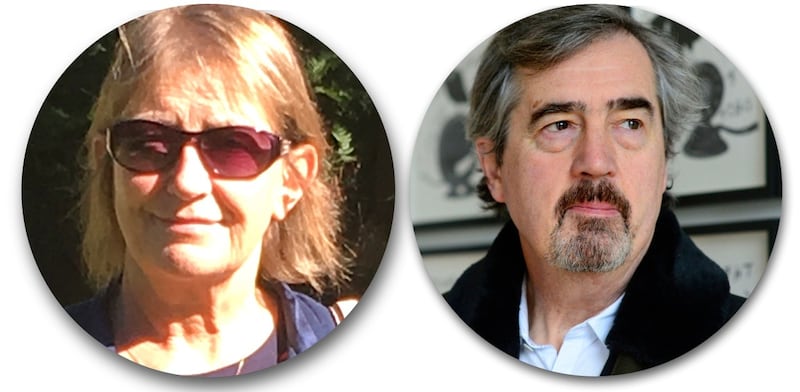
The sculptor Vivienne Roche and I are on Zoom waiting for the laureate for Irish fiction, Sebastian Barry, to join us to talk about their seaweed-sculpted work. His broadband, he explains, is run "by fairies in the mountain".
They first met almost 30 years ago when Barry’s wife was working on a theatre piece with Roche’s then husband, and they found themselves in Co Cork minding small children together. “I knew Viv was also this incredible sculptor and somehow by sheer fluke, a beautiful fluke, I felt that she understood me in a special way and I understood her and we saw each other’s work as an expression of the thing that we valued in each other.”
“Would it be fair to say, Sebastian, that the beach became our shared ground at that point?” asks Roche. “Because you had the twins and I had a baby, and Sebastian and I used to go off with his old car with three children under one.”
“We were fast friends, straightaway,” says Barry. “[We’d go] down to the cove which was, of course, heaving with seaweed. I have had mental health challenges, so you become an expert in spotting the opposite. You become a sort of a connoisseur of happiness . . . being with Viv is an affirmation of your visibility as a human being. I think our friendship has been characterised by a sort of joyful recognition.”
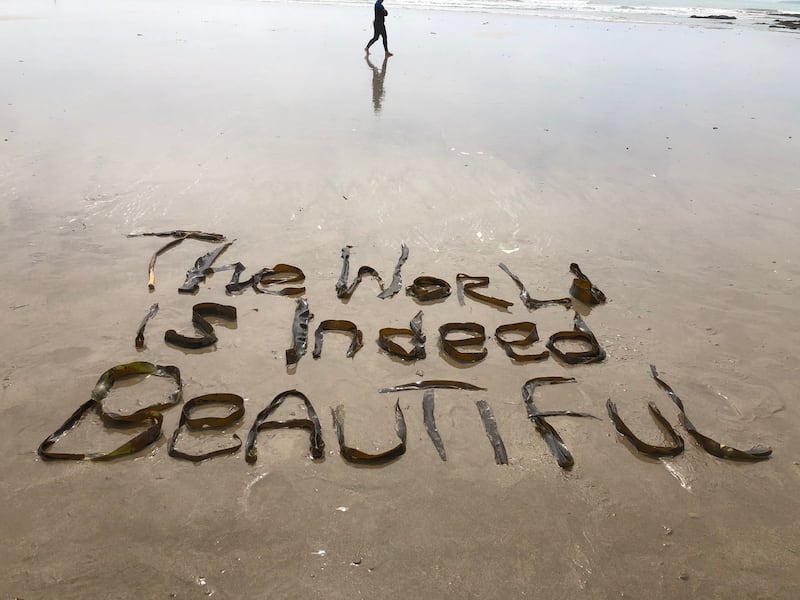
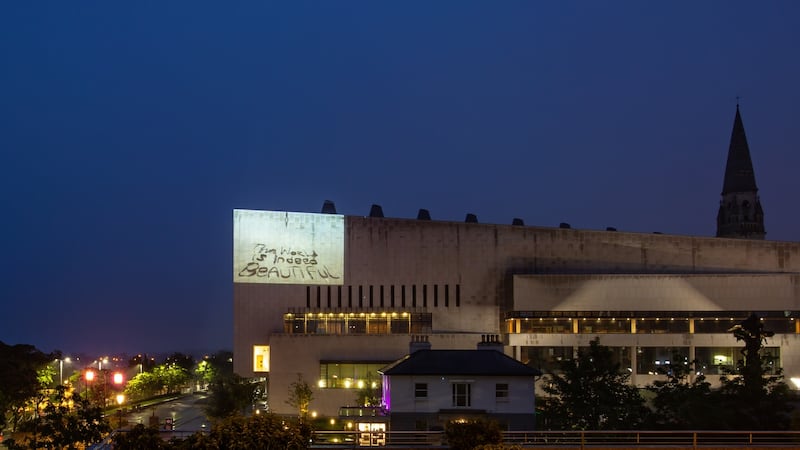
Their artwork is a seaweed sculpted line from Barry’s novel The Secret Scripture, “The world is indeed beautiful”.
“‘Go to work on an egg’ is an age-old adage that still lives with me. I felt that whatever phrase Sebastian would suggest would have to have a great concision in it and be memorable,” says Roche. “In quoting [Barry’s] lines, I immediately thought of the fronds of seaweed, the language of seaweed. There had been a storm maybe two days previously, a very serious, big storm that threw up heaps of seaweed on to the beach.”
“The beach is like a manuscript isn’t it, Viv?” says Barry. “And the seaweed is an almost desperate effort to just scribble something on it. But it can be made articulate by devious intentions of human creatures.”
So, after their initial conversation, Roche headed down to the beach. “I had no idea what I could do,” she says. “Your parting comment to me was ‘There might be some flotsam’ and I knew I was not going to work with that.” They laugh.
“Forgive me,” says Barry.
Roche has seen depression in people close to her. Barry had a breakdown on a book tour in America in 1999. “I came back absolutely shattered. It interests me now [that] it never occurred to me to lift the phone and say, ‘Can you help me?’. [With depression] all the beauties of the world, even drinking coffee with your spouse or tasting the burnt sausage on your toast, are not available to you anymore. The slow replacement of those things can only happen through some form of dialogue, some form of conversation.”
They talk a little about their experiences in lockdown. Barry recalls telling a close friend who had coronavirus that he loved him. “What we’re all talking about in men’s mental health, is that they learn these mysterious calligraphies of seaweed, so that we can speak to each other and not be embarrassed by it and get the rescue that we need,” he says.
“My grandfather used to touch the webs of spiders in his back garden to make the big spiders come out because they thought it was flies. Similarly, when we’re throwing a message up on a building in Dublin, it’s to elicit the beginning of clarity.”
“It’s a real collaboration where the image came from the two of us,” says Roche.
“It was a 30-year conversation,” says Barry. “But we came up with the idea in 10 minutes.”
Domino Whisker & Gavin Friday
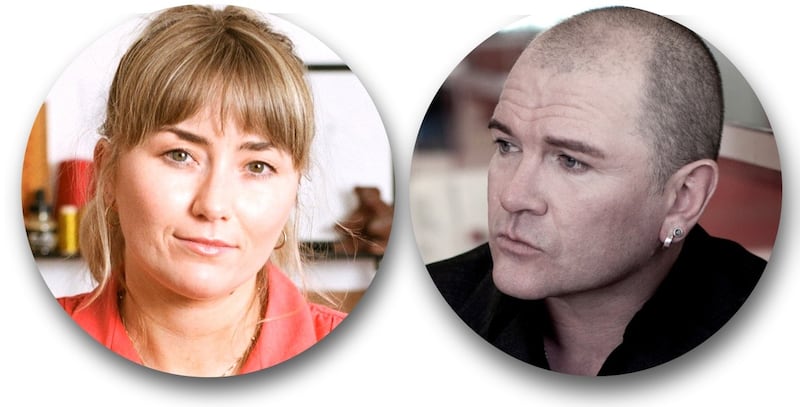
The musician Gavin Friday was a friend of Domino Whisker’s family and has been, she says, like an artistic godfather to her. “I remember him showing up with a bag full of records and saying, ‘Now study this’,” says Whisker. “A few years later we went to see the Slits together. He’s always been a huge influence on my life.”
She’s always been comfortable talking with Friday about her feelings. “My parents split up and I was real angry at my dad and Gav really let me be angry. He always sussed when I was pissed off. He’d pull me aside and say it was okay.”
"I came from a dysfunctional relationship with my dad," says Friday. "Thankfully just before he passed we did talk the big talk." He laughs. "It felt like a Jim Sheridan movie."
Whisker is now a carer for her father, the artist Charlie Whisker, who has Alzheimer's disease. Coming home to Dublin to care for him was a turning point, she says. "I would have been quite closed off and secretly anxious [but] I got really tired of pretending that I was okay. I thought, 'This is my life and I have to make talking about it normal'. I'm probably happier in the last five years even though they've been terribly tragic in many ways because I'm not holding anything in anymore."
They talk about the taboos around mental health and opening up conversations with friends, relatives or health professionals. Friday has always advocated openness and found music to be “a place where I could get my heart and anger out”.
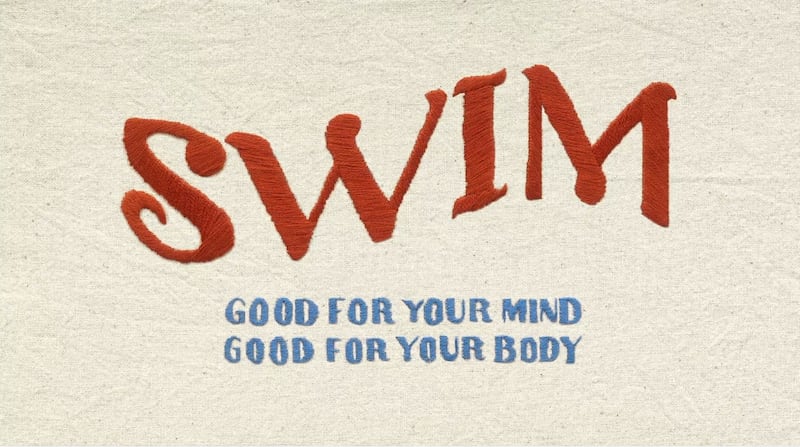
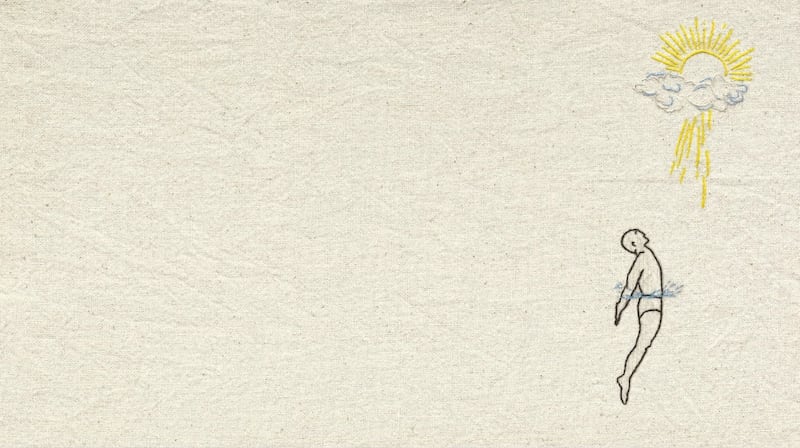
Whisker discovered something similarly cathartic in embroidery. “I’d seen all my Granny’s pieces hanging up on the wall and thought, ‘I could do that’. It started with simple messages that I’d written in my diary, things like ‘I’m fragile’ and ‘I’m in an unfamiliar place’.”
How did their collaboration work? “The same word came out of our mouths spontaneously,” says Whisker, “Swim.”
She has found swimming “a lifesaver,” she says. “I remember driving past Seapoint [in south Dublin] one day and thinking, ‘I have to do something to get out of whatever funk I’m in’. I just went down to the sea and jumped in. I’ve been doing it almost every day since.”
Their piece is an animated sequence, embroidered by Whisker, with text by Friday. It depicts a man under a cloud diving into the water before rising towards the sun. The text declares: “Swim! Good for your mind. Good for your body. Swimming alleviates anxiety and depression.”
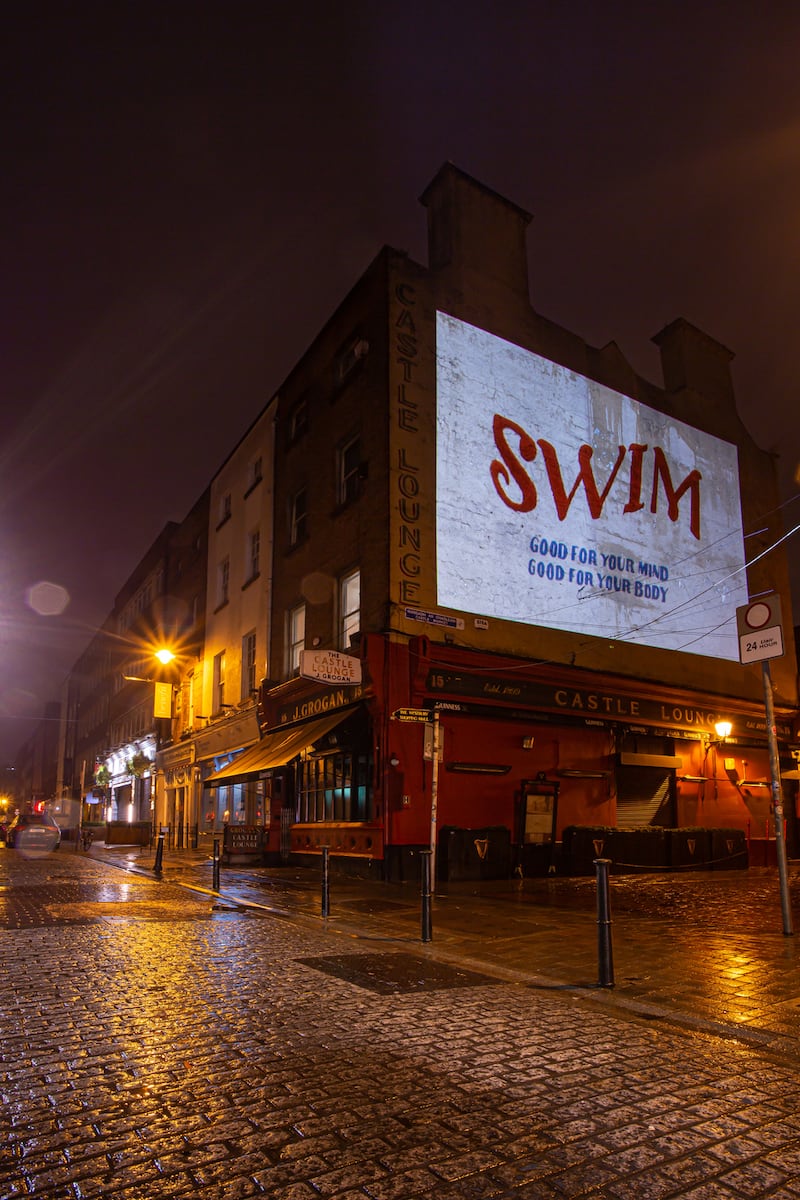
They’re particularly excited that this will be projected on the side of Grogan’s pub in Dublin city centre. “One of my favourite wall pieces in Dublin is the ‘Why go bald’ sign,” says Friday, tapping his own head. “A lot of people have this inferiority complex about art, an idea you have to go into the art gallery. I like the idea of a guy walking down the road to get a bus seeing this and having something click in his head.”
“A really beautiful thing for me,” says Whisker, “is that my dad and Gavin did a little bit of work together and even though my dad might not really understand when I tell him I’m working with Gav, he would be so proud. That’s full circle for me.”
Mundy & Aches
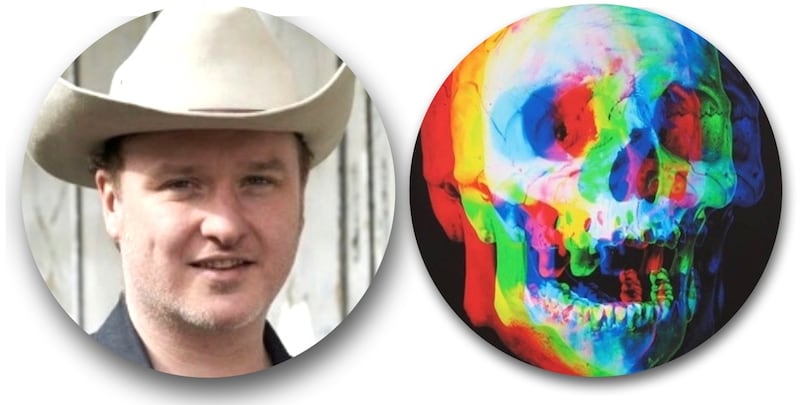
The songwriter Mundy and street artist Aches had never met before their collaboration. Now the words “Kiss me and tell me it’s not broken” from Mundy’s song To You I Bestow are being projected on the side of Busáras, rendered by Aches and animated by his friend Cyan Ryan.
Mundy recalls writing the line after a break-up. “We were after having a party and this line went around in my head. After debating for an hour whether to get out of bed to write it down, because it was so cold, I wrote it on a Yellow Pages [telephone directory].When you’re going through a change of any description, whether it’s for good or for bad, there’s an artistic rush. You really have to hop on that train.”
Is Aches as conscious of his emotions when he’s making art? “I don’t consciously go into the studio and go ‘Oh, this is what’s going on in my life’. [But] I love going out painting on my own if I’m stressed out or anxious about something. With graffiti, it’s mostly young men that do it. Mental health is a big issue. A lot of graffiti artists have passed away, have taken their own lives.”
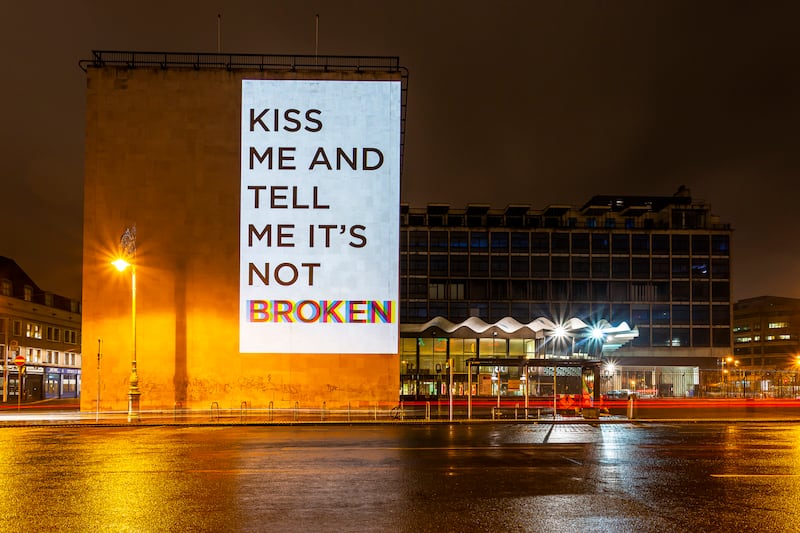
Are men talking about mental health more? “People are starting to say, ‘I’m finding this quite tough’,” says Mundy. “A few years ago, I don’t think people were that open and frank about how they felt.”
"In my friend group, it's still slow," says Aches. Some of Aches's work is influenced by the anxious ways people consume social media. "For this [project] I wanted to keep the design really clean. Nowadays everyone is scrolling, scrolling. I really want it to be impactful and quick and easy for people to enjoy. Because regardless of what you put up there now, it could be the Mona Lisa, they're just going to flick through it, [phones are] making people numb to creativity."
How are they finding lockdown? "I found it very challenging," says Mundy, "but I started doing a Facebook gig every Sunday night and that's keeping me sane. Covid is slowly but surely getting people down. If you listen to the city, there's an atmosphere that's not quite there . . . the chatter as you're walking down the streets. I think it's just coincidental timing that we're doing this but every little helps. Is that the slogan for Tesco?" He laughs.
"I wrote [those lyrics] on the back of a Yellow Pages in a flat in Rathmines, so to now see it on the f***ing side of Busáras, it breathes a bit of life into the song." He pauses. "I wrote that song 26 years ago."
“It’s two years younger than me,” says Aches. Mundy and I, both the same age, groan in pain. Mundy recovers. “To see it blown up like that and given new life, it’s an honour.”

















